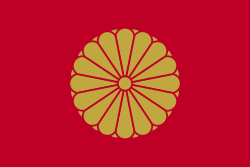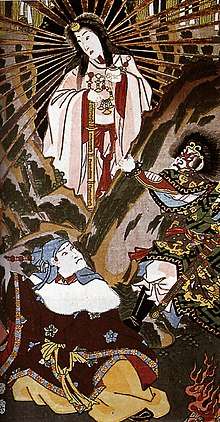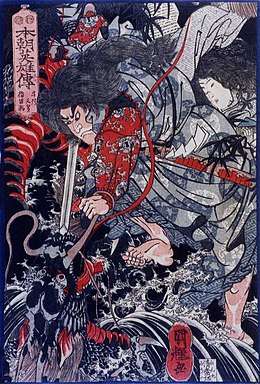Emperor Jimmu
According to Shinto religious myth, Emperor Jimmu (神武天皇, Jinmu-tennō) was the first Emperor of Japan. His accession is traditionally dated as 660 BC.[3][4] In Japanese mythology, he was a descendant of the sun goddess Amaterasu, through her grandson Ninigi, as well as a descendant of the storm god Susanoo. He launched a military expedition from Hyuga near the Seto Inland Sea, captured Yamato, and established this as his center of power. In modern Japan, Jimmu's mythical accession is marked as National Foundation Day on February 11. However, most scholars agree upon that Emperor Kinmei (欽明天皇, Kinmei-tennō, 509AD–571AD) is the first verifiable Japanese Emperor.
| Jimmu | |
|---|---|
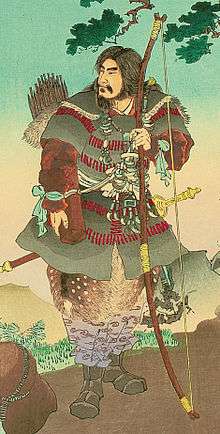 | |
| Emperor of Japan | |
| Reign | February 11, 660 BC – April 9, 585 BC[1][2] |
| Successor | Suizei |
| Born | February 13, 711 BC Japan |
| Died | April 9, 585 BC (aged 126) Japan |
| Burial | Unebi-yama no ushitora no sumi no misasagi (畝傍山東北陵) (Kashihara, Nara) |
| Spouse | |
| Issue | |
| Father | Ugayafukiaezu |
| Mother | Tamayori-hime |
| Religion | Shinto |
| Emperor Jimmu | |||||
|---|---|---|---|---|---|
| Japanese name | |||||
| Kanji | 神武天皇 | ||||
| |||||
Name and title
Jimmu is recorded as Japan's first ruler in two early chronicles, Nihon Shoki (721) and Kojiki (712).[1] Nihon Shoki gives the dates of his reign as 660–585 BC.[1] In the reign of Emperor Kanmu (737–806),[5] the eighth-century scholar Ōmi no Mifune designated rulers before Ōjin as tennō (天皇, "heavenly sovereign"), a Japanese pendant to the Chinese imperial title Tiān-dì (天帝), and gave several of them including Jimmu their canonical names. Prior to this time, these rulers had been known as Sumera no mikoto/Ōkimi. This practice had begun under Empress Suiko, and took root after the Taika Reforms with the ascendancy of the Nakatomi clan.[6]
According to the legendary account in the Kojiki, Emperor Jimmu was born on February 13, 711 BC (the first day of the first month of the Chinese calendar), and died, again according to legend, on April 9, 585 BC (the eleventh day of the third month).
Both the Kojiki and the Nihon Shoki give Jimmu's name as Kamu-yamato Iware-biko no Mikoto (神倭伊波礼琵古命) or Kamu-yamato Iware-biko no Sumeramikoto (神日本磐余彦天皇).[7] Iware indicates a toponym whose precise purport is unclear.
Among his other names were: Wakamikenu no Mikoto (若御毛沼命), Kamu-yamato Iware-biko hohodemi no Mikoto (神日本磐余彦火火出見尊) and Hikohohodemi (彦火火出見).
The Imperial House of Japan traditionally based its claim to the throne on its putative descent from the sun-goddess Amaterasu via Jimmu's great-grandfather Ninigi.[8]
Consorts and children
Consort: Ahiratsu-hime (吾平津媛), Hosuseri's (Ninigi-no-Mikoto's son) daughter
- First son: Prince Tagishimimi (手研耳命)
- Prince Kisumimi (岐須美美命)
Empress: Himetataraisuzu-hime (媛蹈鞴五十鈴媛), Kotoshironushi's daughter
- Prince Hikoyai (日子八井命)
- Second son: Prince Kamuyaimimi (神八井耳命, d.577 BC)
- Third son: Prince Kamununakawamimi (神渟名川耳尊), later Emperor Suizei
Legendary narrative
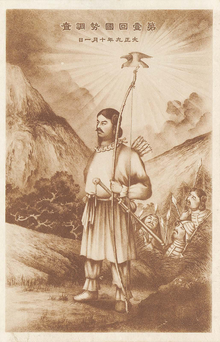
In Japanese mythology, the Age of the Gods is the period before Jimmu's accession.[9]
The story of Jimmu seems to rework legends associated with the Ōtomo clan (大伴氏), and its function was to establish that clan's links to the ruling family, just as those of Suijin arguably reflect Mononobe tales and the legends in Ōjin's chronicles seem to derive from Soga clan traditions.[10] Jimmu figures as a direct descendant of the sun goddess, Amaterasu via the side of his father, Ugayafukiaezu. Amaterasu had a son called Ame no Oshihomimi no Mikoto and through him a grandson named Ninigi-no-Mikoto. She sent her grandson to the Japanese islands where he eventually married Konohana-Sakuya-hime. Among their three sons was Hikohohodemi no Mikoto, also called Yamasachi-hiko, who married Toyotama-hime. She was the daughter of Ryūjin, the Japanese sea god. They had a single son called Hikonagisa Takeugaya Fukiaezu no Mikoto. The boy was abandoned by his parents at birth and consequently raised by Tamayori-hime, his mother's younger sister. They eventually married and had four sons. The last of these, Kamu-yamato Iware-biko no mikoto, became Emperor Jimmu.[11]
Migration

According to the chronicles Kojiki and Nihon Shoki, Jimmu's brothers were born in Takachiho, the southern part of Kyūshū in modern-day Miyazaki Prefecture. They moved eastward to find a location more appropriate for administering the entire country. Jimmu's older brother, Itsuse no Mikoto, originally led the migration, and led the clan eastward through the Seto Inland Sea with the assistance of local chieftain Sao Netsuhiko. As they reached Naniwa (modern-day Osaka), they encountered another local chieftain, Nagasunehiko ("the long-legged man"), and Itsuse was killed in the ensuing battle. Jimmu realized that they had been defeated because they battled eastward against the sun, so he decided to land on the east side of Kii Peninsula and to battle westward. They reached Kumano, and, with the guidance of a three-legged crow, Yatagarasu ("eight-span crow"), they moved to Yamato. There, they once again battled Nagasunehiko and were victorious.
In Yamato, Nigihayahi no Mikoto, who also claimed descent from the Takamagahara gods, was protected by Nagasunehiko. However, when Nigihayahi met Jimmu, he accepted Jimmu's legitimacy. At this point, Jimmu is said to have ascended to the throne of Japan. Upon scaling a Nara mountain to survey the Seto Inland Sea he now controlled, Jimmu remarked that it was shaped like the "heart" rings made by mating dragonflies, archaically akitsu 秋津.[12] A mosquito then tried to steal Jimmu's royal blood but since Jimmu was a god incarnate Emperor, akitsumikami (現御神), a dragonfly killed the mosquito. Japan thus received its classical name the Dragonfly Islands, akitsushima (秋津島).
According to the Kojiki, Jimmu died when he was 126 years old. The Emperor's posthumous name literally means "divine might" or "god-warrior". It is generally thought that Jimmu's name and character evolved into their present shape just before[13] the time in which legends about the origins of the Yamato dynasty were chronicled in the Kojiki.[5] There are accounts written earlier than either Kojiki and Nihon Shoki that present an alternative version of the story. According to these accounts, Jimmu's dynasty was supplanted by that of Ōjin, whose dynasty was supplanted by that of Keitai.[14] The Kojiki and the Nihon Shoki then combined these three mythical dynasties into one long and continuous genealogy.
The traditional site of Jimmu's grave is near Mount Unebi in Kashihara, Nara Prefecture.[15]
Modern veneration

Veneration of Jimmu was a central component of the imperial cult that formed following the Meiji Restoration.[16] In 1873, a holiday called Kigensetsu was established on February 11.[17] The holiday commemorated the anniversary of Jimmu's ascension to the throne 2,532 years earlier.[18] After World War II, the holiday was criticized as too closely associated with the "emperor system."[17] It was suspended from 1948 to 1966, but later reinstated as National Foundation Day.[17][19]
Between 1873 and 1945 an imperial envoy sent offerings every year to the supposed site of Jimmu's tomb.[20] In 1890 Kashihara Shrine was established nearby, on the spot where Jimmu was said to have ascended to the throne.[21]
Before and during World War II, expansionist propaganda made frequent use of the phrase hakkō ichiu, a term coined by Tanaka Chigaku based on a passage in the Nihon Shoki discussing Emperor Jimmu.[22] Some media incorrectly attributed the phrase to Emperor Jimmu.[23] For the 1940 Kigensetsu celebration, marking the supposed 2,600th anniversary of Jimmu's enthronement, the Peace Tower[24] was constructed in Miyazaki.[25]
The same year numerous stone monuments relating to key events in Jimmu's life were erected around Japan. The sites at which these monuments were erected are known as Emperor Jimmu Sacred Historical Sites.[26]
See also
Notes
- "Jimmu", Japan: An Illustrated Encyclopedia (1993), Kodansha, ISBN 978-4069310980.
- "Genealogy of the Emperors of Japan" at Kunaicho.go.jp; retrieved August 28, 2013.
- Kelly, Charles F. "Kofun Culture", Japanese Archaeology. April 27, 2009.
- Kitagawa, Joseph. (1987). On Understanding Japanese Religion, p. 145, p. 145, at Google Books; excerpt: "emphasis on the undisrupted chronological continuity from myths to legends and from legends to history, it is difficult to determine where one ends and the next begins. At any rate, the first ten legendary emperors are clearly not reliable historical records."
Boleslaw Szczesniak, "The Sumu-Sanu Myth. Notes and Remarks on the Jimmu Tenno Myth", in Monumenta Nipponica, Vol. 10, No. 1/2 (1954), pp. 107–126. - Aston, William. (1896). Nihongi, pp. 109–137.
- Jacques H. Kamstra Encounter Or Syncretism: The Initial Growth of Japanese Buddhism, Brill 1967 pp. 65–67.
- 神倭伊波礼琵古命, OJ pronunciation: Kamu-Yamatö-ipare-biko (nö-mikötö) Donald Philippi, tr. Kojiki, University of Tokyo Press, 1969 p. 488
- Bob Tadashi Wakabayashi, [Japanese Loyalism Reconstrued: Yamagata Daini's Ryūshi Shinron of 1759], University of Hawai'i Press, 1995 pp. 106–107.
- Nussbaum, "Jindai" at p. 421, p. 421, at Google Books.
- Jacques H. Kamstra, Encounter Or Syncretism: The Initial Growth of Japanese Buddhism, Brill 1967 pp. 69–70.
- Nussbaum, "Chijin-godai" at p. 111, p. 111, at Google Books.
- Kennedy, Malcolm D. A History of Japan. London. Weidenfeld & Nicolson, 1963.
- Ooms, Herman. Imperial Politics and Symbolics in Ancient Japan: the Tenmu Dynasty, 650–800. Honolulu: University of Hawai'i Press, 2009
- Imperial Household Agency (Kunaichō): 神武天皇 (1); retrieved August 22, 2013.
- "Nationalism and History in Contemporary Japan". Retrieved February 11, 2017.
- "Kigensetsu Controversy", Japan: An Illustrated Encyclopedia (1993), Kodansha. ISBN 978-4069310980.
- Britannica Kokusai Dai-Hyakkajiten article on "Kigensetsu".
- "Founding Day rekindles annual debate". The Japan Times. February 11, 1998. Retrieved May 24, 2014.
- Martin, Peter. (1997). The Chrysanthemum Throne: A History of the Emperors of Japan, p. 18–20.
- Kashihara City website tourism page on "Kashihara Jingū".
- Britannica Kokusai Dai-Hyakkajiten article on "Hakkō ichiu".
- Dower, John W., War Without Mercy: Race & Power in the Pacific War, faber and faber, 1993 p.223.
- Peace Tower (平和の塔, Heiwa no Tō, originally called the "Hakkō Ichiu Tower" 八紘一宇の塔 Hakkō Ichiu no Tō or the "Pillar of Heaven and Earth" 八紘之基柱 Ametsuchi no Motohashira)
- Motomura, Hiroshi (February 10, 2015). "Miyazaki's controversial Peace Tower continues to cause unease". The Japan Times. ISSN 0447-5763. Retrieved February 9, 2018.
- Ruoff, Kenneth J. (September 9, 2014). Imperial Japan at Its Zenith: The Wartime Celebration of the Empire’s 2,600th Anniversary. Cornell University Press. p. 41. ISBN 9780801471827. Retrieved February 10, 2018.
References
- Aston, William George. (1896). Nihongi: Chronicles of Japan from the Earliest Times to A.D. 697, Volume 1. London: Kegan Paul, Trench, Trubner. OCLC 448337491
- Brown, Delmer M. and Ichirō Ishida, eds. (1979). Gukanshō: The Future and the Past. Berkeley: University of California Press. ISBN 978-0-520-03460-0; OCLC 251325323
- Brownlee, John S. (1997). Japanese Historians and the National Myths, 1600–1945: The Age of the Gods. Vancouver: University of British Columbia Press. ISBN 0-7748-0645-1
- Chamberlain, Basil Hall. (1920). The Kojiki. Read before the Asiatic Society of Japan on April 12 10 May, and June 21, 1882; reprinted, May 1919. OCLC 1882339
- Earhart, David C. (2007). Certain Victory: Images of World War II in the Japanese Media. Armonk, New York: M. E. Sharpe. ISBN 978-0-7656-1776-7
- Kitagawa, Joseph Mitsuo. (1987). On Understanding Japanese Religion. Princeton: Princeton University Press. ISBN 9780691073132; ISBN 9780691102290; OCLC 15630317
- Nussbaum, Louis-Frédéric and Käthe Roth. (2005). Japan encyclopedia. Cambridge: Harvard University Press. ISBN 978-0-674-01753-5; OCLC 58053128
- Ponsonby-Fane, Richard Arthur Brabazon. (1959). The Imperial House of Japan. Kyoto: Ponsonby Memorial Society. OCLC 194887
- Titsingh, Isaac. (1834). Nihon Ōdai Ichiran; ou, Annales des empereurs du Japon. Paris: Royal Asiatic Society, Oriental Translation Fund of Great Britain and Ireland. OCLC 5850691
- Varley, H. Paul. (1980). Jinnō Shōtōki: A Chronicle of Gods and Sovereigns. New York: Columbia University Press. ISBN 978-0-231-04940-5; OCLC 59145842
External links
- A more detailed profile of Jimmu (archived April 2011)
- A detailed summary of Jimmu's descent legend (archived July 2014)
Emperor Jimmu Born: 13 February 711 BC Died: 9 April 585 BC | ||
| Regnal titles | ||
|---|---|---|
| New creation | Emperor of Japan 660–585 BC (traditional dates) |
Succeeded by Emperor Suizei |
